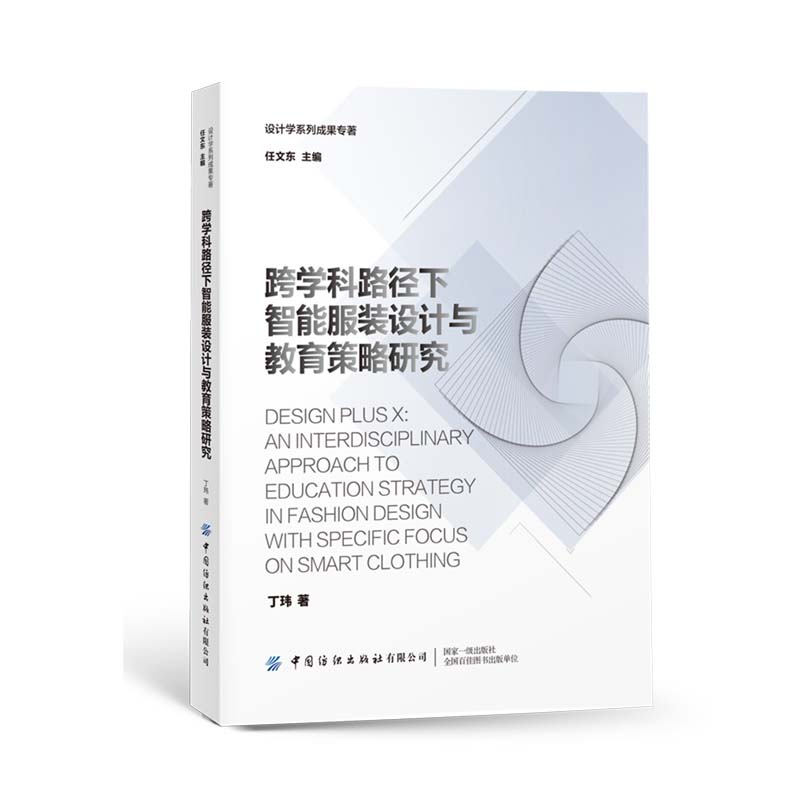- ISBN:9787518083565
- 装帧:一般纯质纸
- 册数:暂无
- 重量:暂无
- 开本:16开
- 页数:160
- 出版时间:2021-11-01
- 条形码:9787518083565 ; 978-7-5180-8356-5
内容简介
The cultivation of interdisciplinary human talent in the field of fashion design is an urgent issue for technological innovation and development and socioeconomic development, while also conforming to the principle of growth of innovative human talent, and becoming a global trend towards reform in design education.
目录
Introduction
1.1 Research Background
1.1.1 The Demand Trends in the Fashion Market
1.1.1.1 The Future of Fashion
1.1.1.2 Existing Wearables and Smart Clothing Market Landscape and
Market Size
1.1.2 The Current Situation of Fashion Design Education
1.1.3 Summary
1.2 Research Questions
1.3 Research Aim
1.4 Scope of Research
1.4.1 Knowledge Science
1.4.2 Fashion Design
1.4.3 Smart Clothing Design
1.4.4 Smart Technology
1.5 Research Methods
1.6 Research Contributions
1.7 Structure of the Thesis
Chapter 3
Create New Thinking Approach for the Fashion Design Education Field
3.1 Design Plus X: An Interdisciplinary Thinking
Approach to Education Strategy in Fashion Design
3.1.1 Design Plus Humanities and Sociology
3.1.2 Design Plus Management
3.1.3 Design Plus Technology
3.2 Design Practice Process of "DPX"
3.2.1 Workshop 1: Market
3.2.2 Workshop 2: Product
3.2.3 Workshop 3: Technology
3.2.4 Workshop 4: Prototype
3.3 Keeping the Process of "DPX" Alive
3.4 Summary
Chapter 4
The DPX Case Studies in Fashion Design Education: New Strategy for Interdisciplinary Practical Education with Specific Focus on Smart Clothing
4.1 Case Study 1
4.1.1 Research Introduction
4.1.2 Research Questions
4.1.2.1 The Comfort of Clothing
4.1.2.2 Quantitative Research on the Comfort
4.1.2.3 The Comfort in Infant Clothing Design
4.1.2.4 Definition of Research Questions: the Conflict Between the Comfort
and Accuracy
4.1.3 The Traditional Solution
4.1.4 The Solution of the Project
4.1.5 Experimental Design
4.1.5.1 Measuring Body Temperature
4.1.5.2 Machine Learning Framework
4.1.5.3 Feature Design
4.1.5.4 Training
4.1.5.5 Testing
4.1.6 Experimental Results
4.1.7 Summary
4.2 Case Study 2
4.2.1 Research Introduction
4.2.2 Technical Support
4.2.2.1 Working Theory of the Sensor
4.2.2.2 Working Theory of the Temperature Controller
4.2.2.3 Working Theory of a Color Sensor
4.2.2.4 Technical Support for Embedding Design
4.2.3 Experimental Design
4.2.3.1 Relationship Diagram of the Main Components of the System
4.2.3.2 Specific Control Procedure Flow
4.2.3.3 Process Flowchart
4.2.3.4 Temperature Setup
4.2.4 Color- and Temperature-recognition Experiments
4.2.5 Analysis of the Experimental Results
4.2.6 Summary
Chapter 5
Discussions and Conclusions
5.1 Research Discussions
5.2 Research Conclusions
5.2.1 Research Contributions
5.2.1.1 Research Contribution 1
5.2.1.2 Research Contribution 2
5.2.2 Suggestions for Further Research
Reference
Acknowledgements
作者简介
中国香港理工大学纺织与制衣系硕士,日本北陆先端科学技术大学院大学知识科学博士。大连工业大学服装学院院长,教授,博士研究生导师。中国服装设计师协会学术委员会理事,教育部学位中心研究生论文评审专家,中国国际教育学会高级研究员,时尚产业人才成长联盟高校数字艺术专业委员会理事,国际学术期刊JournalofGlobalTourismResearch 特邀编辑。主要研究方向:数字化服装、智能纺织品与服装面料创新设计、跨学科教育研究。
-

当代中国政府与政治(新编21世纪公共管理系列教材)
¥33.6¥48.0 -

落洼物语
¥8.7¥28.0 -

中国当代文学名篇选读
¥19.1¥53.0 -

中医基础理论
¥50.7¥59.0 -

北大人文课(平装)
¥13.9¥45.0 -

宪法-第二版
¥12.2¥29.0 -

当代中国政府与政治 第二版
¥57.8¥68.0 -

EPLAN电气设计
¥29.9¥39.8 -

闯进数学世界――探秘历史名题
¥21.3¥32.8 -

企业法务教程
¥34.8¥49.0 -

习近平新时代中国特色社会主义思想概论
¥18.2¥26.0 -

金融学
¥29.9¥49.0 -

计算机操作系统教程(第4版)(清华大学计算机系列教材)
¥31.9¥49.0 -

三国史
¥27.5¥50.0 -

陶瓷坯釉料制备技术/高职高专材料工程技术专业
¥37.4¥45.0 -

陶瓷工艺技术
¥41.7¥49.0 -

飞机总体设计
¥46.8¥78.0 -

陶瓷工艺学/焦宝祥
¥41.7¥49.0 -

古代汉语(第四册)
¥16.1¥35.0 -

编辑审稿实务教程
¥35.1¥45.0













